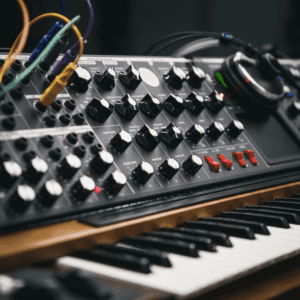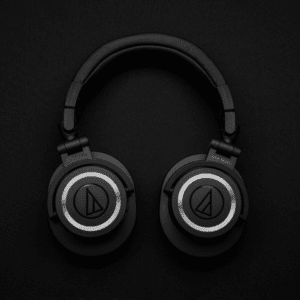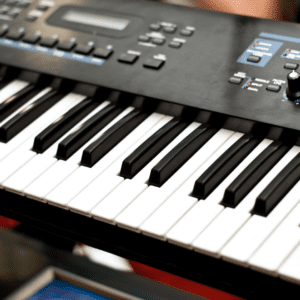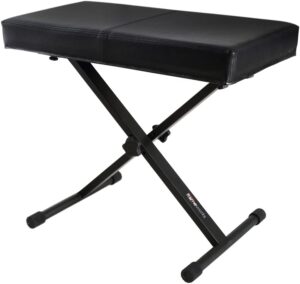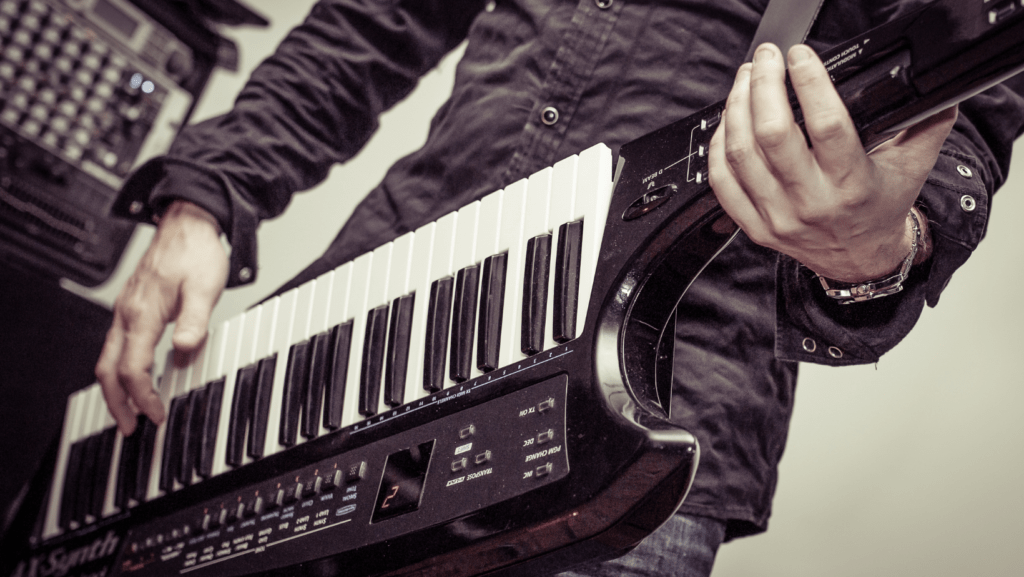
Keyboard instruments have been popular for a very long time and show no signs of losing their esteemed place in the world of music. Guitars are often the stars of live music shows as they’re considered more alluring and exciting to watch than the keyboard. This is where to keytar comes in. It gives the keyboard player the ability to move around the stage and interact with the audience. Gone are the days when the keyboardist is stuck behind his/her other bandmates whilst the guitarists and singers get all the attention.
With that in mind, let’s look at some of the best keytars on the market today.
| 1. Best Overall Keytar – Alesis Vortex 2 An affordable model with everything you need, including 8 RGB pads, sliders, and Bluetooth connectivity. | Buy on Amazon | |
| | 2. Best Beginner Keytar – Yamaha Sonogenic Keytar A streamlined keytar with 37 compact keys, built-in speakers, and Bluetooth. It includes Jam mode which is a useful tool for beginners to learn songs. | Buy on Amazon |
| | 3. Most Versatile Keytar – Behringer MS-101 Monophonic Keytar A retro re-make, with 32 full-sized semi-weighted keys. Comes with loads of onboard sounds that are fully adjustable to custom parameters. | Buy on Amazon |
| | 4. Best Professional Keytar – Roland AX-Edge 49-Key Keytar A 49-key model with aftertouch, 500 inbuilt sounds, mic input, and a vocoder. It’s available in 4 different colors. | Buy on Amazon |
| | 5. Best Keytar With A Vocoder – Yamaha Vocaloid Keyboard VKB-100 A niche, streamlined and compact keytar that focuses on the inbuilt vocoder. It can also be played like a regular keytar. | Buy on Amazon |
5 Best Keytars Reviewed
Best Overall Keytar – Alesis Vortex 2
The Alesis Vortex 2 is one of the most popular keytar models out there. It’s a midi controller keyboard with a lot of options, which makes it a popular choice for studio environments as well as live performances. It comes with 37 velocity-sensitive keys with aftertouch, 8 RGB backlit, velocity-sensitive trigger pads, which allows you to create beats or launch samples. There are also 8 programmable sliders for you to use for EQ or anything else you like.
The neck has a pitch bend wheel, a volume slider, zone sustain, and a touch strip, as well as octave control buttons. The Vortex 2 works on either USB power or 4 AA batteries, which can give you range and mobility when you play.
The Bluetooth connectivity comes from an included Bluetooth dongle which provides a strong and stable wireless connection. The Vortex 2 is a quality, lower-end midi-controller that gives the feel and experience of more complex workstations at a fraction of the cost.
Pros
- Affordable price yet still contains just about everything you need.
- 8 RGB backlit, velocity-sensitive pads.
- 8 programmable sliders.
- Improved Bluetooth technology.
- Can be powered by USB for the studio, or 4 AA batteries for live performances.
Cons
- Some complain it’s not very user-friendly and comes without support or instructions.
Best Beginner Keytar – Yamaha Sonogenic Keytar
The Yamaha Sonogenic Keytar is a compact instrument that comes with 37 keys that are slightly smaller than usual. It’s well suited to beginners as it comes with a feature known as jam mode, which lets you play in time with songs whilst correcting any wrong notes you may play. Some players lament the lack of advanced features on this instrument.
Another great feature of this instrument is that it comes with inbuilt speakers, meaning you can play it as it is or plug it straight into an amp without having to run it through any other gear. It’s a good choice for a beginner’s keytar yet it still has enough features to keep you interested for a while.
Also included is a free chord tracking app that helps novices learn their way around the instrument. It has MIDI 1/0 so it can be used as a midi controller. There’s also Bluetooth, a USB connection, and ¼” and 3.5mm jacks, giving plenty of options for players with needs passing those of complete beginners.
Pros
- Compact 37 keys.
- Jam mode lets you play along with songs you don’t know.
- Inbuilt speakers.
- Bluetooth-enabled.
Cons
- Smaller-sized keys may take some getting used to if you’re used to normal-sized ones.
- Doesn’t contain as many bells and whistles as other models
Most Versatile Keytar – Behringer MS-101 Monophonic Keytar
The Behringer MS-101 Monophonic Keytar is a replica of the iconic Roland SH-101 and is creating quite a stir in the keyboard world. It’s more or less the same dimensions as the original although it has slightly rounded corners and is marginally less deep. The keys are full-size and the instrument has a design that no doubt will be pleasing to many.
The instrument is analog, which makes it unique in this arena nowadays. The onboard sounds are top quality, meaning you can pay homage to the past whilst still forging your way into the future. Included is a guitar strap and attachable handgrip (with pitch bend wheel and a pitch modulation trigger), for when you’re ready to take center stage.
True to the original design, the MS-101 gives you the ability to replicate the tones of your favorite synth of bygone eras or the ability to make a name for yourself with your own unique sound design.
Pros
- Monophonic synthesizer with authentic 3340 analog oscillators.
- 32 full-sized, semi-weighted keys for incredible playability.
- Analog signal path based on the coveted VCO, VCF, and VCA designs.
- 6 FM sources allow for unparalleled VCF filter effects.
Cons
- There are some complaints about some keys being out of alignment.
Best Professional Keytar – Roland AX-Edge 49-Key Keytar
The Roland AX-Edge 49-Key Keytar is the latest offering from Roland stands out from the rest due to the quality of its onboard sounds. Couple with the ability to play external sounds as well, this keytar really does offer the musician many sonic options to experiment with.
It contains Bluetooth, MIDI capabilities, that can play for up to 4 hours with one charge of the batteries. It also has 49 keys with aftertouch, as opposed to the 37 that are more common with other makers.
Another point worth making is that many people claim to be surprised at the quality of the 500 preset sounds and 79 sound effects, not expecting them on this kind of instrument. You can also choose from four different colors to suit your personality and musical character.
Pros
- 49 keys with aftertouch.
- 500 good preset sounds and 79 sound effects.
- Built-in mic input and vocoder.
- Available in four different colors.
Cons
- On the expensive side.
Best Keytar With A Vocoder- Yamaha Vocaloid Keyboard VKB-100
Whilst only released in Japan, the Vocaloid has caused quite a stir in the keyboard world. It’s similar in build to the previously mentioned Sonogenic Keytar and also has the same limited connectivity options.
The main attraction of the Vocaloid is the inbuilt vocoder, alongside its large store of inbuilt vocal sounds that can be adjusted to your tastes and requirements. It can also be played as a ‘regular’ keytar. This instrument is unique and if you want to get the specific sounds that it can produce you won’t be able to replicate it easily any other way.
On the Vocaloid, you can program your melody and lyrics into the instrument. Afterwards, you can edit the sound by changing dynamics, adding vibrato, and so on. It’s a popular instrument in making anime soundtracks. Whilst its specific features make it a niche instrument, it’s still worth a mention here, and many people are hoping that it’ll be available outside of Japan soon.
Pros
- Inbuilt vocoder.
- Can also be played as a normal keytar.
- A unique niche instrument unlike anything else currently available.
Cons
- Limited connectivity options
Keytar Buying Guide
History Of The Keytar
The keytar first became commercially available in the 1980s where it was briefly popular, after quickly falling out of favor. Nowadays it is seeing a resurgence in popularity with live performers and even as a studio instrument.
The keytar first came about in the 1970s. Edgar Winter first put a strap on his ARP 2600 synthesizer. Jan Hammer popularised the instrument further with his work, especially on the soundtrack of the television series Miami Vice. The first instrument available to the public was the Moog Liberation in the 1980s and was known as the keytar. Most keytars come with 37 velocity-sensitive full-size keys, although some are larger than this.
The original idea behind the keytar was to give keyboardists the freedom to move around the stage like their bandmates. The early keytars, however, were too heavy and meant players were unable to use them for full shows. Modern times have seen advancements in these instruments, making them much lighter and more manageable.
Another breakthrough that has seen a resurgence in the popularity of the keytar is the possibility of using them as a MIDI controller. As such they have become more popular in electronic music and beyond.
How Do You Play The Keytar?
The keytar is held in place with a strap around the shoulder of the player. It’s typically played standing up and is used mostly for solos. The right hand plays melodies whilst the left hand is on the neck which contains further controls like pitch bend and customisable mod-wheels or sliders.
The point of the keytar is the flexibility and mobility it gives the player to move around the stage and interact more with other band members and the audience. It’s played with a strap slung over the shoulder with a few controllers for you to alter the sound.
The early keytars (and synths for that matter) were very heavy and bulky and proved difficult for people to play for prolonged periods. Modern instruments are much lighter and streamlined making playing for prolonged periods easier. Because of the way they’re held, they’re more suited to one hand playing for solos, as opposed to two-handed playing common with keyboards on stands.
Is The Keytar Easy to Learn?
Provided you already have some basic knowledge of the keys beforehand, the biggest challenge you may face is learning how to play standing up. The keytar is mostly played with the right hand, with the left-hand on the neck controlling parameters such as pitch bend and octave shift.
Most piano and keyboard players are used to playing sitting down, so learning to play standing up will present its own unique set of challenges. Also, as the keytar came about from a desire for greater showmanship from keyboardists, it may be time to start working on your stage presence and persona, if you’re planning on playing live.
You’ll also have to learn how to use the controllers present on the neck of the keytar. It might take some time learning how to use them seamlessly, especially during live performances.
Wired or Wireless?
Since mobility was a key design impetus in the keytar, you may want to consider one with wireless capabilities. This will add to the sense of freedom you feel when playing and performing and adds to the modern look of the instrument.
Remember also that if the instrument you’ve decided on doesn’t come with wireless capabilities, you can always add it on after with an audio transmitter/receiver.
What Features Do You Want in Your Keytar?
Most keytars nowadays are MIDI enabled, meaning you can play virtually any instrument through them electronically. Another important feature to bear in mind when choosing an instrument are the connectivity options that it offers you.
How Heavy/Light Should A Keytar Be?
Most keytars nowadays weigh under 10 pounds, meaning that they’re light enough for you to be able to move around freely with.
The earliest keytars were very heavy and clunky instruments that made it difficult to play them for extended periods and move around a lot. Nowadays, most keytars are much lighter, giving you greater freedom of movement. If you’re likely to want to dance and jump around when playing your keytar, consider choosing the lightest model you can find to avoid fatigue.
Are The Aesthetics Of The Keytar Important?
Since the keytar was designed for keyboard players to be able to be more active and involved with live performing, the aesthetics of the keytar may be important for some people.
The fact that the instrument was developed in direct response to the need for keyboardists to receive more attention from the audience, the overall look of the instrument might be something you want to take into account.
On the whole, keytars look fairly similar, so there’s not too much to worry about. However, the Yamaha models tend to look a little less rock’n’roll than some of the others on the market, in my opinion. The more bare looks may appeal to artists who lean aesthetically to a more minimalist
look.
Are Onboard Sounds Important For You?
Most early keytars were MIDI controllers without any inbuilt sounds, meaning you had to plug them into any other controller you already had. Nowadays, there are keytars with inbuilt sounds, meaning they can be played as stand-alone instruments that don’t require MIDI.
MIDI is essentially computer signals that tell the computer what note you played, how hard, and so forth. With MIDI you can play just about any sound, from piano to guitar to flute to synth, and beyond.
To Sum Up
The keytar is growing in popularity now after its initial rise and fall out of favor. Nowadays live bands are constantly looking for new ways to keep their audiences captivated and are trying to make their shows unique in every way possible. In light of this, many are adopting keytars into their shows for the added showmanship they can provide. Gone are the days when key-playing members of the band are invisible and overshadowed by the others.
Our overall top pick, the Alesis Vortex 2 provides a superb entry point into the marvelous world of keytars. Its features put it above more basic entry-level models such as what’s on offer from Yamaha. The Alesis Vortex 2 is great value and gives the musician enough options to keep him or herself musically excited as you grow musically, as a performer and keytar player.
Last update on 2023-04-27 / Affiliate links / Images from Amazon Product Advertising API


